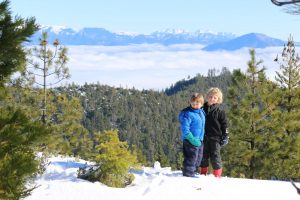
Once away from the coast, the climate becomes much more extreme. As locals know, the marine layer and fog that can blanket the coast during the summer months rarely penetrates past the first tier of mountains. Vegetation changes with oak woodlands replacing redwood forests. This part of the county touches on what David Rains Wallace calls the “Klamath Knot” – the confluence of Cascade and Sierra, a tumbling together of plant species, an unexpected abundance of biological diversity.
The best hiking opportunities are in the Six Rivers National Forest (SRNF), BLM’s Lacks Creek Management Area, and along several rural roads. Sadly, the lack of support for and maintenance of trails in SRNF often requires a spirit of adventure. Several walks have also been included from the communities of Blue Lake and Willow Creek.
It is not unusual for inland county roads to pass through open range with privately held land on both sides of the road for considerable distance. As discussed in the “Introduction”, the public right-of-way is widely variable although generally extends a minimum of 40 feet. This does require care when parking and vigilance to keep from straying from the road. The intimidating signs often posted along rural roads are much more bark than bite. All this being said, the best strategy is avoid confrontation, explain your purpose when asked, and use common sense.
- Blue Lake Industrial Park and Mad River Levee
- Upper Fickle Hill Road
- Mountain View Road
- Bald Mountain and Snow Camp Road
- Walking in the Horse Mountain Area
- Indian Butte Loop
- Trinity Alps Vista
- Cold Springs Wander
- Spike Buck Mountain
- East Fork Willow Creek
- Boise Creek
- Lacks Creek
- Pine Ridge
- Mid-Slope Road/Pine Ridge Loop
- Willow Creek Walks
- Brush Mountain Fire Lookout
- “Prospect” Trail
- Bluff Creek Historical Trail
- Shelton Butte
Other options in the area that deserve a brief mention: Lower Bair Road


There is a brand new road sign marking the upper trailhead for Prospect Trail, on the Gasquet-Orleans Rd. The comment in the book about the lack of marking for this trailhead produced action! There is not yet a trail sign right at the start of the trail, at the edge of the parking lot, but one is planned. The central section of the trail has been affected by a very difficult tangle of trees from a big blowdown. One of the U.S.F.S. fire crews has been able to start work clearing it, work to be completed by Nov. 22, 2019. Trail users should understand that there is no assurance that it will be possible for the crew to clear 100% of the fallen trees this season. In particular, there is one long suspended log that runs lengthwise along the trail. It is currently necessary for hikers to walk along this log, and some may not be comfortable with this. To clear this will be a difficult, complex cut. Otherwise, most of the length of the trail, in from both the upper and lower trailheads, was cleared of most obstacles in 2017, making it easily passable. (A few logs that can be clambered over remain.) Be aware that poison oak is abundant along the top section of the trail.
Logging out, brushing out, and general maintenance on the Bluff Creek Historical Trail were completed between 2017 and 2019. The main trail, including the switchbacks at the bottom end, mentioned in the book, is in fine condition. The extension north into the canyon of Bluff Creek (mentioned in the book) is not a Forest Service-maintained trail.